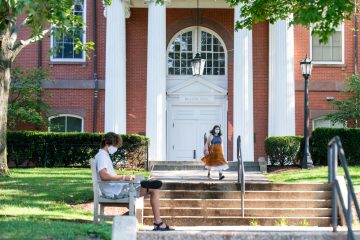
Last month, Tufts Trustee and TFN Advisory Committee Member Jeff Moslow, A86, A16P, A18P, asked Executive Vice President Mike Howard to discuss the impact of COVID-19 on Tufts’ financial state and how the university is adapting to ensure its future fiscal health, all while continuing to meet its academic and research mission.
Mike has overseen finance and administration since joining Tufts’ senior leadership team from Smith College in 2019. Recently, he has played a critical role helping the university respond to the fiscal challenges presented by the pandemic. He has also established several working groups to develop guidance on a range of issues, including health and wellness; academic research and operational continuity; and student life.
This interview was conducted at the beginning of the 2020 fall semester.
Jeff Moslow: Describe the financial impact of COVID-19 on Tufts’ operating results for fiscal year 2020. Assuming the university remains fully operational for the fall semester, what is the expected impact for 2021?
Mike Howard: For fiscal year 2020, the primary financial impact was the revenue loss in housing and dining when students returned home in the spring and the loss of income at the clinics in the Dental and Cummings Schools, which were only able to see emergency patients per state guidelines on physical distancing. This was approximately $22 million. The university acted quickly and put in place several measures to control expenses and conserve cash, including holds on wage increases, hiring, discretionary spending and capital projects. As a result, we expect a 1% surplus for our fiscal year 2020 operating results, essentially equal to what we were projecting before the pandemic.
The impact for fiscal year 2021 will be more significant. Revenue losses coupled with incremental expenditures for COVID-19 testing, monitoring and support services total over $100 million. The university has taken some additional actions to offset these effects and is projecting to break-even financially for the year.
What will the impact be if we have to pivot to a fully remote semester?
Each month that the residential program is not operational costs us about $9 million. The impact of a fully remote semester will be about $40 million.
Can you walk us through the steps Tufts is taking at the highest levels to adapt to the new environment and the additional costs of preparedness?
When the pandemic began, President Monaco brought senior leaders together and asked us to focus on a few clear objectives:
- Protect the health and well-being of our community members.
- Continue our educational and research mission in the safest way possible.
- Use our expertise, where possible, to assist local communities and peer institutions.
It is with this focus and Tufts’ spirit of collaboration and civic mindedness that we have been able to fundamentally transform the university in such a short period. First, we designed and implemented a medical surveillance and health services operation for the entire university. Next, we addressed the need for courses to be offered in person and online. We changed class schedules and classroom layouts to provide adequate social distancing. All residential students are also provided PPE and tested twice a week, including those living off-campus. Faculty and staff on campus are also tested weekly. This amounts to approximately 2,700 tests per day. We also mobilized modular housing units for quarantined students, adding over 200 additional residential beds to the Medford/Somerville campus. As they did for the summer, most staff continue to work remotely.
The additional cost for this is substantial and will be close to $30 million for the year.
How has the pandemic impacted Tufts’ endowment performance and fundraising?
Investment returns in fiscal year 2020 were not strong on an absolute basis. The uncertainty of the pandemic led to a sharp decline in global markets. Markets eventually recovered and returns for the year were 3.7 percent, despite the substantial decline in the endowment in March, which recovered its losses by the end of the year. Final performance numbers are still being finalized and performance relative to peers will not be available for several months.
Performance over five- and ten-year periods continues to be strong, both in terms of benchmarks and relative to our peers. Importantly, over these periods, returns continue to meet our objective of spending rate plus inflation, ensuring the purchasing power of the endowment is maintained.
Giving to Tufts continues to be very strong. In June, the Brighter World Campaign surpassed the $1 billion mark of a $1.5 billion goal. Total fundraising achievement in fiscal year 2020 was $170 million, including $22 million in annual gifts and $58 million in gifts to the endowment.
The pandemic and resulting financial uncertainty underscore the importance of the endowment to the long-term financial health of the university. As stressing events become more frequent, gifts to the endowment create a stable, perpetual funding source for critical elements of the university’s operations such as scholarships and professorships. This enables us to maintain our commitment to excellence in academics and research.
Can you discuss the liquidity of Tufts today and any steps the university is taking to prepare for further deterioration in the current environment?
Tufts is continuing the measures put in place when the pandemic began to preserve cash and liquidity. Cash levels and liquidity remain at the upper end of our target levels, and the university recently increased its available line of credit. Tufts continues to be viewed very favorably by the credit rating agencies, and our core programs have exceptionally high demand.